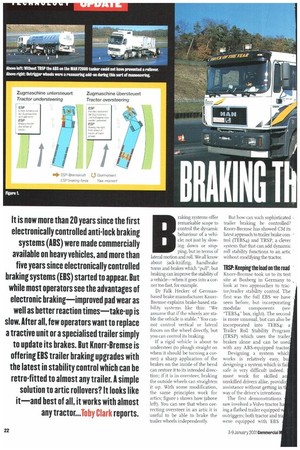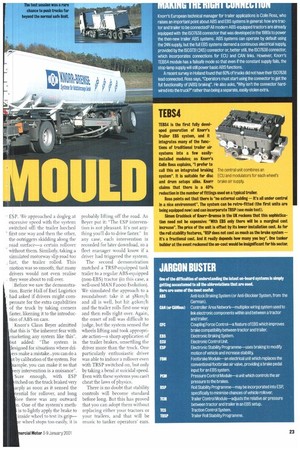BAKING T OUL
Page 22

Page 23

If you've noticed an error in this article please click here to report it so we can fix it.
ralcing systems offer remarkable scope to control the dynamic behaviour of a vehicle; not just by slowing down or stopping, but in terms of lateral motion and roll. We all know about jack-knifing, handbrake turns and brakes which "pull", but braking can improve the stability of a vehicle—when it goes into a corner too fast, for example.
Dr Falk Hecker of Germanbased brake manufacturer KnorrBremse explains brake-based stability systems like this: "We assume that if the wheels are stable the vehide is stable." You cannot control vertical or lateral forces on the wheel directly, but you can control its braking.
If a rigid vehicle is about to understeer (to plough straight on when it should be turning a corner) a sharp application of the brakes on the inside of the bend can restore it to its intended direction; if it is in oversteer, braking the outside wheels can straighten it up. With some modification, the same principles work for attics; figure i shows how (above left). You can see that when correcting oversteer in an artic it is useful to be able to brake the trailer wheels independently.
But how can such sophisticated trailer braking be controlled? Knorr-Bremse has showed CM its latest approach to trailer brake control (TEBS4) and TRSP, a clever system that that can add dynamic roll stability functions to an artic without modifying the tractor.
IISP: Keeping the load on the road Knorr-Bremse took us to its test site at Boxberg in Germany to look at two approaches to tractor/trailer stability control. The first was the full EBS we have seen before, but incorporating modular components (see "TEBS4" box, right). The second is more unusual, but can also be incorporated into TEBS4: a Trailer Roll Stability Program (TRSP) which uses the trailer brakes alone and can be use with any ABS-equipped tractor
Designing a system whic works is relatively easy, bu designing a system which is fai safe is very difficult indeed. must work for skilled a unskilled drivers alike, providit assistance without getting in t way of the driver's intentions.
The first demonstrations
saw involved a Volvo tractor h ing a flatbed trailer equipped' outriggers; both tractor and tr,
were equipped with EBS
E S P. We approached a dogleg at excessive speed with the system switched off: the trailer lurched first one way and then the other, the outriggers skidding along the road surface—a certain rollover without them. Similarly, taking a simulated motorway slip road too fast, the trailer rolled. This motion was so smooth, that many drivers would not even realise they were about to roll over.
Before we saw the demonstration, Barrie Hall of Exel Logistics had asked if drivers might compensate for the extra capabilities of the truck by taking corners faster, likening it to the introduction of ABS on cars.
Knorr's Claus Beyer admitted that this is "the inherent fear with
marketing any system like this", ut added: "The system is esigned for situations where dri'ers make a mistake.. .you can do a t by calibration ofthe system, For ample, you can make it so that ery intervention is a nuisance". Sure enough, with ESP -itched on the truck braked very arply as soon as it sensed the tential for rollover, and long 'ore there was any outward n. One of the system's meth
is to lightly apply the brake to inside wheel to test its grip
e wheel stops too easily, it is probably lifting off the road. As Beyer put it: "The ESP intervention is not pleasant. It's not anything you'll do to drive faster." In any case, each intervention is recorded for later download, so a fleet manager would know if a driver had triggered the system.
The second demonstration matched a TRSP-equipped tank trailer to a regular ABS-equipped (non-EBS) tractor (in this case, a well-used MAN Fz000 Evolution). We simulated the approach to a roundabout: take it at 38km/h and all is well, but hit 4okm/h and the trailer rolls first one way and then rolls right over. Again. the onset of roll was difficult to judge, but the system sensed the wheels lifting and took appropriate action—a sharp application of the trailer brakes, unsettling the driver more than the truck. One particularly enthusiastic driver was able to induce a rollover even with TRSP switched on, but only by taking a bend at suicidal speed. Even with these systems you can't cheat the laws of physics.
There is no doubt that stability controls will become standard before long. But this has proved that you can adopt them without replacing either your tractors or your trailers, and that will be music to tanker operators' ears.




























































































































